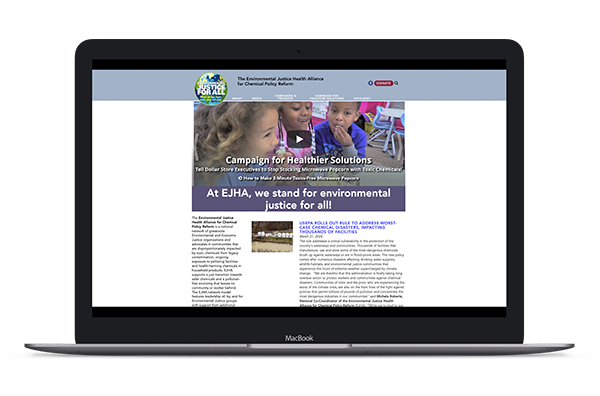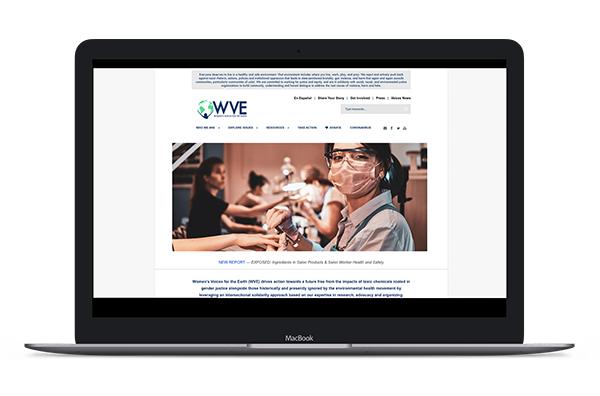 Policy Brief + Recommendations
Policy Brief + RecommendationsThe consumer-focused holidays are here, with Black Friday, Small Business Saturday, Cyber Monday and more. This season presents an opportunity to give gifts that are memorable and special while minimizing impacts on people and our planet.
In a world where our “stuff” increasingly impacts our climate, communities, and planet, you have the power to advance a more sustainable future. Share love for your family, strengthen your community, and protect the environment by making healthier choices – something we can all celebrate.
Ready to get started? We’ve gathered the best resources to ensure your holidays support a world where all people and the planet thrive.
Celebrate Differently Your Guide to Meaningful Giving
The most treasured gifts often can’t be found in a big-box store. This holiday season, discover the joy of giving that creates connections, supports your community, and nurtures our shared environment. Here are wonderful ways to make your celebrations more meaningful:
Create Memories Together
Transform your gift-giving into shared experiences that build lasting bonds. Cook a festive meal with loved ones, enjoy a local theater performance, or spend a day volunteering for a cause you support. These moments can become stories you’ll tell for years to come.
Embrace Cultural Traditions
Take inspiration from the heartwarming Icelandic tradition of Jólabókaflóð, where families gift books and spend cozy evenings reading together by the fireplace. Choose books from your local library and create your own version of this beautiful custom.
Give from the Heart
Transform simple ingredients into treasured gifts by creating homemade treats in charming mason jars. Or explore your local Buy Nothing Group, where the spirit of reuse and community sharing turns pre-loved items into new treasures.
Empower Change
Make your giving go further by supporting Indigenous and Black-owned businesses, or celebrating Giving Tuesday (December 3rd) by contributing to organizations working toward a healthier world. If Habitable made your list, your contribution for a healthier world can be made here.
Shop Mindfully
When purchasing new items, you have more tools than ever to make choices that align with your values:
- Explore the Environmental Working Group’s Consumer Guides to discover products that meet high standards for health and sustainability
- Use the DetoxMe app from Silent Spring Institute to make informed choices about everyday products
- Check the Retailer Report Card from ToxicFreeFuture to support companies leading the way in sustainable practices
Support Local Artisans
Your community is filled with talented artists, craftspeople, and ethical manufacturers whose work tells a story. When you choose their creations, you’re not just giving a gift – you’re investing in your local economy and helping creative spirits thrive.
Inspiration for the Journey
Deepen your understanding and find inspiration through these enriching resources:
- Watch “Buy Now: The Shopping Conspiracy” on Netflix, an eye-opening documentary that reimagines our relationship with consumption and charts a path toward positive change
- Be moved by “The Green Buffalo,” showcasing the Lower Sioux Indian Community’s inspiring journey toward sustainable housing and economic renewal
- Explore The Serviceberry, a new book by Dr. Robin Wall Kimmerer, offering a fresh perspective on our relationship with consumption and nature
This holiday season, let’s celebrate the power we have to create positive change through our choices. Every mindful decision, every local purchase, and every shared experience builds momentum toward a future where our celebrations honor both people and planet.
Together, we can make this holiday season one of connection, purpose, and joy.
Wishing you a season filled with meaningful moments,
The Habitable Team

Habitable’s report, “Advancing Health and Equity through Better Building Products,” reveals the current state of building materials used, with nearly 70% of typical products in the categories analyzed containing or relying on the most hazardous chemicals.
The results, based on data for Minnesota affordable housing, are consistent with products used in other building types and geographic regions. The report highlights examples of leaders within and beyond Minnesota’s built environment who are already taking action toward safer material choices. It also provides guidance on how the real estate industry can begin working toward a healthier future by “stepping up from red-ranked products”—the most polluting and harmful throughout their life cycle based on Habitable’s research and Informed™ product guidance.
The Equitable and Just National Climate Platform is a collaborative effort between environmental justice and national environmental groups to develop inclusive and equitable national climate policy ideas and advocate for shared policy goals.

The Environmental Justice Health Alliance for Chemical Policy Reform is a national network of grassroots organizations advocating for safer chemicals and a pollution-free economy, focusing on communities disproportionately impacted by toxic chemicals and pollution.

Women’s Voices for the Earth (WVE) advocates for a future free from the impacts of toxic chemicals with a focus on gender justice and intersectional solidarity, using expertise in research, advocacy, and organizing.


A new report reveals that low-income countries, despite using less plastic, face lifetime plastic costs that are ten times higher than those of wealthier nations.
This disparity highlights the structural inequities within the plastics value chain, where the burdens of plastic pollution fall disproportionately on those least equipped to address them, exacerbating the crisis. WWF urges all governments to adopt a treaty with harmonized, binding global rules to eliminate these inequities in our current take, make, and waste plastics system. Such a treaty is essential to ensure a fair and effective global response to plastic pollution.

Learn about the United Nations’ General Comment No. 26, which provides guidance on implementing the UN Convention on the Rights of the Child regarding children’s rights and the environment, focusing on the impact of toxic substances.

The Lower Sioux nation are pioneering a first-of-it’s-kind green experiment with a manufacturing campus that integrates vertical hemp growing, hempcrete insulation processing, and healthy home construction, aiming to address housing and job shortages while reclaiming sovereignty.
Overwhelming evidence suggests our health and well-being are significantly impacted by the conditions in the environment where we are born, live, learn, work, and play, with some suggesting that our zip codes are better predictors of health than our genetic code.
Also referred to as social determinants of health , these conditions range from access to and quality of education, transport, and health care services to housing conditions and the toxics and pollutants we are exposed to in the neighborhoods we live in.
While definitions may vary around what these conditions are and which should be prioritized, there is general consensus that:
- These conditions exist because of decision-making processes, policies, structures, and practices designed and implemented by humans;
- These conditions create inequities in health, disproportionately impacting low-income families, families living with incomes below the federal poverty level, and people of color, and;
- Cross-sector collaboration is needed to deliver the highest standards of health for all, with special attention given to the needs of those who are at greatest risk.

In alignment with efforts tackling the root causes of health inequities, Healthy Building Network (HBN) entered into a partnership with United Renters for Justice (IX), a nonprofit working to transform the Minneapolis housing system, to reduce tenant exposures to toxic chemicals used in building products. Funded through an Environmental Assistance grant by the Minnesota Pollution Control Agency (MPCA), this collaborative project prioritized toxic exposure reduction in areas designated to be of environmental justice (EJ) concern by the MPCA. EJ concern areas include tribal land and census tracts with higher concentrations of low-income residents and people of color – communities that are disproportionately impacted by toxic chemical exposures and other forms of pollution.
This collaboration provided the unique opportunity to embrace the perspective of tenants in the co-creation of resources to help them make informed decisions about the products used in their housing units and common areas. Specifically, this meant designing resources that would leverage IX’s organization and mobilization skills as well as the structure of a recently established tenant cooperative, “A Sky Without Limits.” Also, it meant increasing information accessibility, for example, through the use of non-technical language and making the resources available in both English and Spanish.
Tenant organizations and other stakeholders can access HBN’s healthier building product guidance at informed.habitablefuture.org and by watching this 10-minute seminar video:
Watch the Seminar (English)
Ver el Seminario (Español)
This high-level, 10-minute recording can be used to educate the general public (e.g., tenant meetings) about the importance of avoiding toxic products. It begins by breaking down myths and misconceptions around the perceived hazards and safety of natural and synthetic chemicals and discusses how toxic products impact individuals and families, especially children, along the lifecycle of products.
By empowering the people most affected by toxic chemical exposures to advocate for and create change in their living conditions, this project creates avenues for creating a safer environment for all. Anyone who influences product purchasing decisions – including manufacturers, building owners, managers, developers, architects, investors, policy makers, and consumers – has the power and responsibility to reduce health inequities for those using or exposed to those products every day. This includes residents, workers, installers, and the communities that surround the facilities where these materials are processed and disposed of. By making material health a priority in your decision-making processes, you’ll be joining efforts to tackle the root causes of health inequities in communities around the world. Visit informed.habitablefuture.org to learn how our building product guidance can help you make better material choices.

In this case study, Healthy Building Network and Energy Efficiency for All teamed up to apply a framework for considering life cycle chemical and environmental justice impacts to the primary component of fiberglass insulation: glass fibers.
The case study explores the chemical hazards associated with the manufacture of glass fibers and the localized impacts that facilities have on communities and workers. It includes an example of chemical movements within the supply chain and highlights end of life scenarios for fiberglass insulation. Overall findings are coupled with specific recommendations for policymakers and for manufacturers throughout the supply chain.
Supporting Documents:

 Equity
Equity